|
Monday, February 15, 2010
Progress Notes
A couple of weeks ago I happily announced that Sherril and Alice Steen (photo 01) had made a significant financial donation to the Miller County Historical Society which will greatly increase the financial viability of our museum for its ongoing expenses and operation.
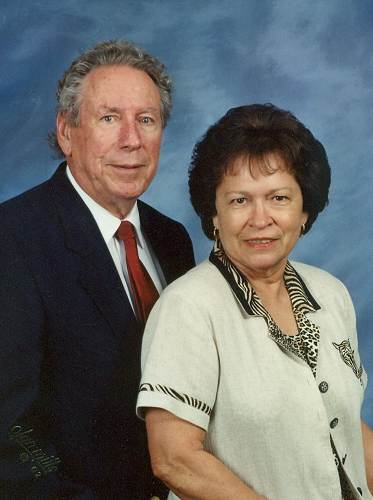
01 Waldo and Alice Steen The announcement of the gift was made in several newspapers including the Eldon Advertiser and Miller County Autogram Sentinel. We have set up the foundation as a vehicle for those who wish to donate funds to our museum to have available to them a tax saving vehicle to do so. Just in the last month we received notification from the state that we now have a state approved foundation for these types of gifts. You can read the complete announcement sent to the news media at the end of the Progress Notes of January 25.
The extended Miller County Steen family has been very kind to the museum in the last several years having made donations of display items and financial contributions. Just last year the Waldo Steen and James Popplewell families had their reunion at the museum (photo 02 - which you can read more about on this previous Progress Notes) and together both made a very substantial financial donation at that time.
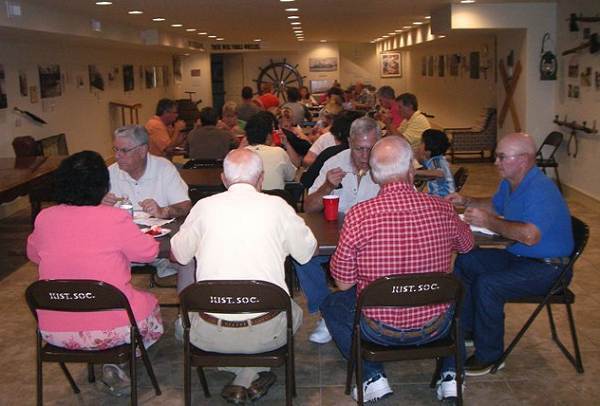
02 Steen Popplewell Reunion - 2009 In addition, last year the Steen family donated to our museum the immense collection of genealogical records and obituaries compiled by Janet Steen (photo 03), daughter of Waldo and Eula Steen, who sadly passed away last year.
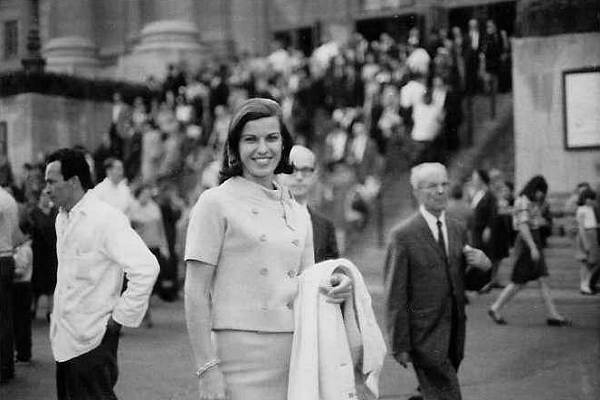
03 Janet Steen And the gift even included a new computer as well! You can read more about Janet and the materials she donated on our website taken from our September Newsletter.
The Steen and Popplewell families have a long history in Miller County. I discussed the Popplewell family on a previous Progress Notes of November 2, 2009 when I told the story of WWII hero, Gail Popplewell.
Sherril Steen’s father, Waldo Steen, was the husband of Eula Popplewell, a brother to Gail Popplewell and daughter of James Popplewell (photo 04).
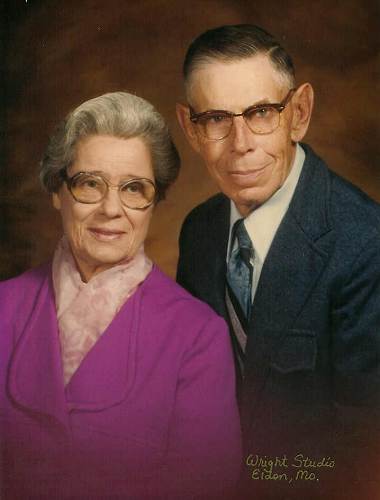
04 Eula and Waldo Steen This week I am going to discuss the Steen family history in Miller County in honor of Sherril and Alice Steen who so graciously made the significant financial contribution which has allowed us to set up the Miller County Historical Society Foundation. The foundation is designed to allow donors to make contributions which allow significant tax advantages.
In the near future, I will also discuss the Miller County Pemberton family history of Alice Pemberton Steen, wife of Sherril, who partnered with her husband in providing their very generous gift. Dana Steen Maloney (photo 05), daughter of Sherril, has researched her mother’s Pemberton family and will present that narrative in future Progress Notes.

05 Dana Maloney Dana has already been featured on Progress Notes a year or more ago when she wrote an essay about her grandfather Waldo Steen’s lost watch. You can read that narrative at this previous Progress Notes from 2008.
The Steen family history in Miller/Camden counties to which I have recurred for much of the information for this narrative was written by Sue Steen Cates (photo 06) published in 1995 in a book she titled “How Do I Fit In.”
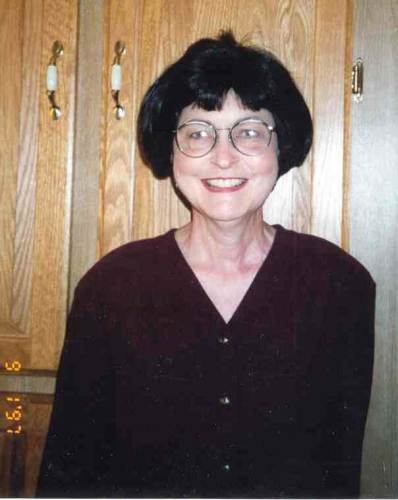
06 Sue Steen Cates We have copies of this book for sale in our museum library. I also have depended on information supplied me by Sherril Steen, who has made previous narrative contributions to my Progress Notes as well as other locations on our website. I recommend you read these articles written by Sherril when you get the opportunity at these URL’s:
- Concrete Homes in Miller County
- My Memories of Our Family’s Poultry Farm Note: You will have to scroll down the page to get to the article about Sherril’s memories about the poultry farm.
- World War II Glider Wreck
I will place here the Steen history for which I have utilized the research of Sue Steen Cates. I have added to it references along the way as to how each historical Steen mentioned by Sue relates to Sherril Steen:
The Name Steen
Legends handed down over time suggest the origin of the name “Steen” comes from multiple sources including, for example, “Stein” from Wales, “O’Steen” from Ireland, and “Steen” from Holland. It does not occur in Irish surnames. In England the name is Steenson, in Germany is Stein, and in Holland is Steen. In Scotland it comes from a reduced form of the personal name Steven.
North German, Dutch, and Scandinavian origins come from sten ‘stone’, hence a topographic name for someone who lived on stony ground, or a metonymic occupational name for someone who worked with stone: a quarryman, stonecutter, or stonemason. The Swedish surname probably originated from the personal name Sten. The “Steen” name in America can be traced back to several European countries in this order: Germany, Norway, Ireland, Scotland, and England. A web search indicates that Steen is a very common last name for both men and women (2433 out of 88799) (1990 U.S. Census). Texas has more “Steens” than any other state.
According to Janie Dennis Weaver, as quoted by Sue Steen Cates in her book, “How Do I Fit In”, the Steen family of Missouri came to America with a large migration of Scotch Irish Presbyterians in the early to middle 1700’s to escape persecution in their home county of Antrim in Ireland. According to Sue, by 1886 there were only three Steens listed in a census for the Irish county of Antrim.
Most of the Steens from Scotland or Ireland first settled in the area of Lancaster County, Pennsylvania and were predominately Scotch Irish Presbyterians. Many migrated south to South Carolina and into Georgia. One of these was James Steen who eventually migrated west to Missouri into what is now Laclede County being found on census lists as early as 1840. He was the fourth great grandfather of Sherril Steen.
One of his sons, Richard, was Sherril’s third great grandfather. One of Richard’s sons, James (Hodge) Steen, moved back and forth between southern Miller County and Camden County during the time of the Civil War. Interestingly, he fought for the North while one of his brothers, George, fought for the South. A family story passed down from generation to generation states that George and Hodge coincidentally faced each other during a battle in Texas. It is said that both of them “wept with joy to know that neither had been killed.” This story, according to Sue Steen Cates, is told in a Laclede County History book. James was buried in Glover Cemetery. He was the second great grandfather of Sherril Steen.
Two sons of James (Hodge), John Brannon Steen and George Steen, eventually became neighbors owning farms near Dean Creek just over the line from Miller County in north eastern Camden County. John took over the family farm owned by James Hodge and George inherited the farm owned by his wife Matilda’s parents, Bennett and Martha Barnett. John Brannon was Sherril Steen’s great grandfather (photo 07).
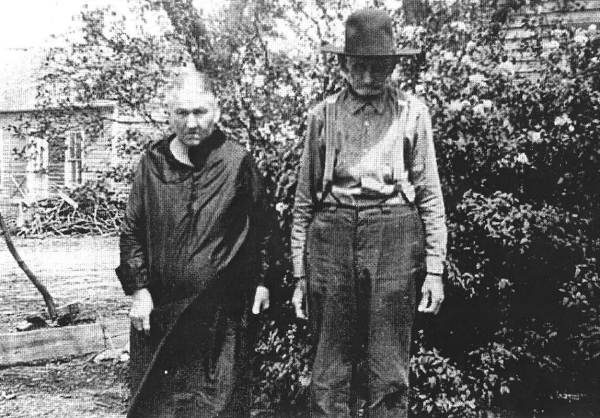
07 John Brannon and Mary Caroline Brannon Steen - 1930 A small school was established by the Steen brothers located in the woods between their home and the small town of Hawkeye. The children of John Brannon Steen and George Steen attended the school which was named Steen School officially but nicknamed “Skin Heel” because of the “rough acts that went on there” according to Sue Steen Cates. Sue continues with the following anecdote:
“When Ab McComb was the teacher, one of George Steen’s boys, Jim, pulled a knife and cut the teacher’s throat; a quick acting student, Betty Workman, got ashes from the stove and stopped the bleeding.”
Frank Steen was one of the eleven children of John Brannon Steen. He attended the small Steen school and continued to live on the home farm for a year after marrying his life long wife, Ella Frances Wall, in 1905 (photo 08).
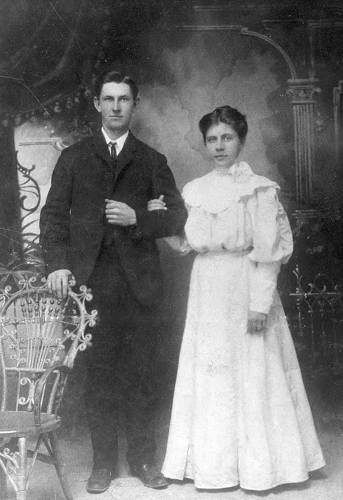
08 Frank Steen and Ellie Wall Wedding Frank and Ella were Sherril Steen’s grandparents.
After the year with John Brannon in 1906, Frank and Ella moved to Miller County to the farm that originally had belonged to her grandparents on her mother’s side, John and Mahala (Barton) Williams. At the time they moved it belonged to Ella’s parents, Floyd and Susannah (Williams) Wall (photo 09).
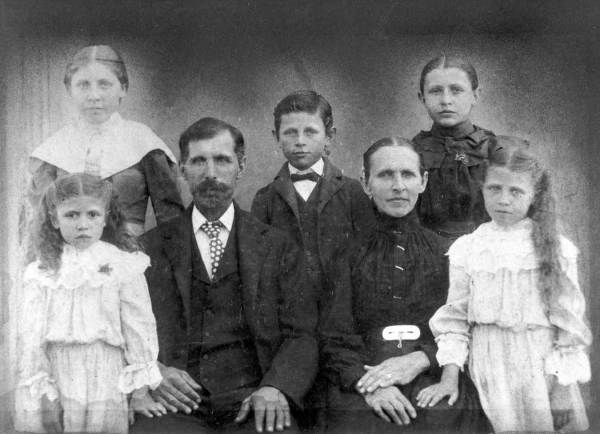
09 Floyd and Susanna Williams Wall, Ella, Alma, Oliver, Emma and Ann - 1899 They later bought the farm which was located four miles west of Iberia and lived there sixty one years. It was on this farm which the old slave cabin now located on the campus of the Miller County Museum originally was located. The home into which they moved was a large concrete house originally built by John Williams, Ella’s grandfather, who had died eleven years earlier (photo 10).
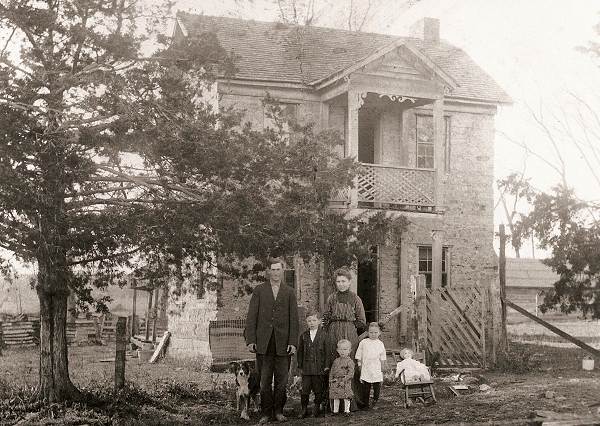
10 Frank, Ellie, Waldo, Virgie and John in front of House Grandpa Williams Built Frank and Ella had seven children, five boys and two girls. They were in order of birth: Waldo, Vergie, John, Kermit, Holmes, Icie, and Paul (photo 11). Waldo was Sherril’s father.
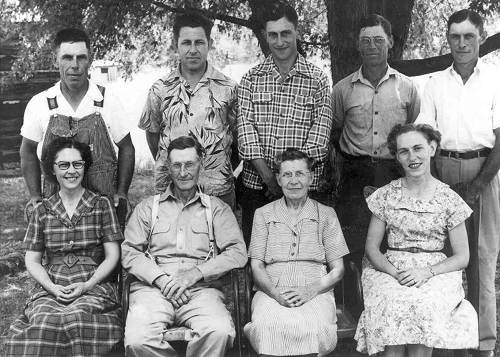
11 Waldo, John, Paul, Kermit, Holmes, Vergie, Frank, Ellie and Icie The Steens’ in Camden County attended the Twelve Points Baptist Church not far from Dean’s Creek. Burials of Steen family members are found in several local cemeteries. Although some of them were thought to be buried in a home graveyard on John Steen’s farm, due to the presence of some old broken tombstones which Sue and her brother Donald Steen located several years ago, most of the Steens were buried in Glover Cemetery (photo 12).
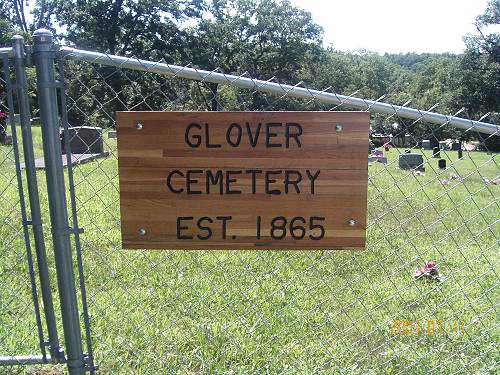
12 Glover Cemetery Their tombstones are some of the oldest ones located there. Two generations of older Steens are believed to have been buried in the Jericho Cemetery near Conway, Missouri. These include James Steen, his son Richard, and Richard’s wife Judah. The last time a family descendent visited the cemetery nothing was left except a few markers propped up against a fence. Frank and Ella Steen were buried in the Williams Cemetery. Two infants belonging to John and Glee Plemmons Steen were buried in unmarked graves in the Hawkins cemetery.
Note: Some time ago I went to Glover Cemetery and photographed the tombstones of John Brannon Steen, George Washington Steen, James Hagges (Hodge) Steen, Matilda, wife of George, and a Nancy Steen, who died very young. Other Steen markers are present but I couldn’t make out their complete names (photos 13 - 17).
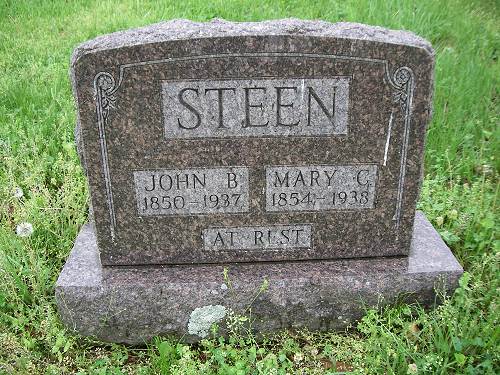
13 John Brannon Steen Headstone
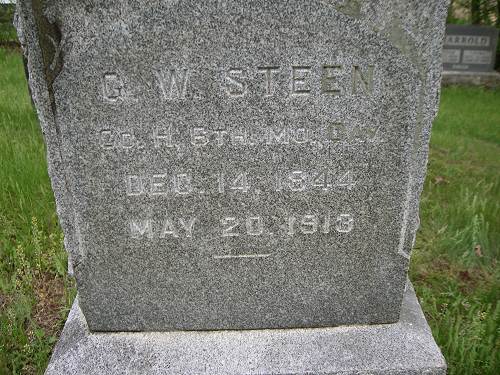
14 George Washington Steen Headstone
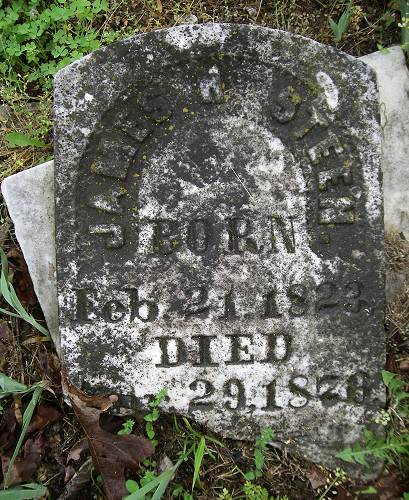
15 James Hodge Steen Headstone
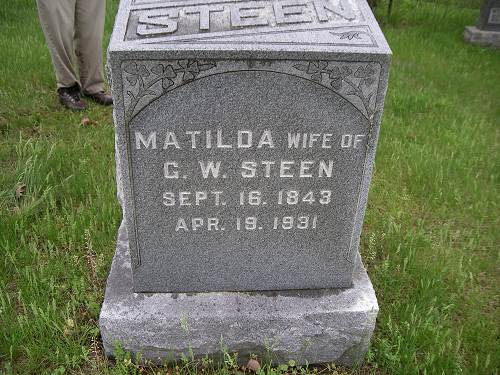
16 Matilda Steen Headstone

17 Nancy Steen Headstone In contrast to the staunch Democrat Williams family, which originally owned the farm where Frank and Ella lived, the Steens were avid Republicans.
Sherril Steen has written an interesting narrative about his boyhood life on the farm his father had purchased from his parents, Frank and Ella Steen, who lived on the farm adjoining:
Technology Changes the Family Farm
Waldo Sherril Steen
From “How Do I Fit In” by Sandra Sue Steen Cates
Our lifestyle has changed dramatically for the better over my lifetime and I suppose some of my Grandchildren and Great grandchildren will have difficulty in relating to the amount of physical labor required just to feed, clothe and shelter a family during the 1930’s. With that in mind, I’ll document some of Mom and Dad’s activities during the early years of their marriage, their investments in new buildings and the latest technology that promised significant improvements in their lifestyle.
My parents, Waldo Amos Steen and Eula Popplewell were married on Sunday, 17, April 1932 and set up house keeping in the old farmhouse on the farm that was later purchased from Frank and Ella Steen on 30 June 1936 for $1500.00 (photos 18, 19 and 20).
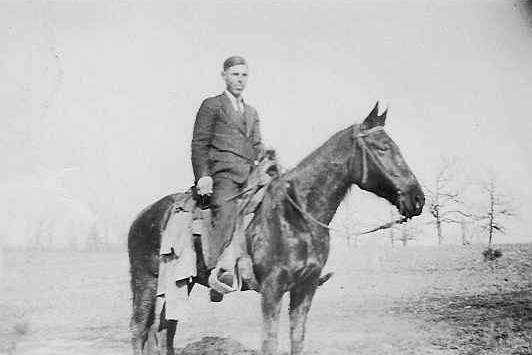
18 Waldo as young man on his horse
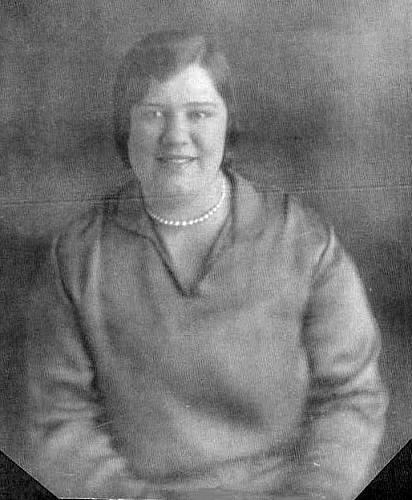
19 Eula Popplewell as young woman - 1929
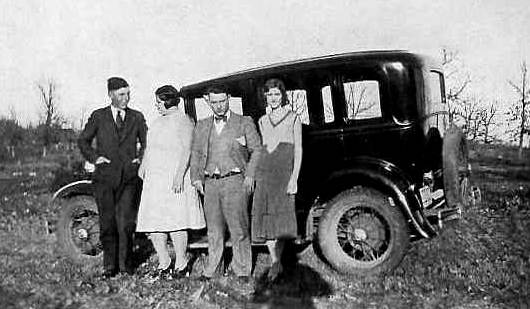
20 Waldo Steen, Eula Popplewell, Curtis Popplewell and Marie Karr The 40 acre farm would not support many horses or cattle and Dad had already begun the construction that would transform the small farm into a modern poultry operation.
Dad built the “30 X 30” (that was the only name ever used to describe this chicken house) prior to their marriage in 1932 out of native rock/lumber and it housed the 1200 chickens that were sold just before the wedding to buy the furniture, wash tub, wash board, skillet, broom and etc. to set up housekeeping.
My view is that the barn, “30 X 30” and outdoor toilet were the only buildings that added any value to the property. The house was in need of repair from the start and never received any of the limited labor and materials that were available. Mom and Dad had planned on replacing the old house with a modern structure and they were content to get by until the dream could be fulfilled. I can remember the wind blowing through the upstairs and snow drifting in on our beds in the winter. Mom and Dad slept in the downstairs bedroom and the kids all slept in one large upstairs room. There was a wood cook stove in the downstairs bedroom and the kids all slept in one large upstairs room. There was a wood cook stove in the kitchen, an icebox on the south porch and a wood heating stove in the living room. I don’t recall any source of heat in the bedrooms. The house was eventually (1938 or 1939) wired for lights and connected to the 32 volt direct current system in the “engine house” and the wood cook stove was replaced with a propane cook stove and oven in the early 40’s. It wasn’t much, but served as the family home from 1932 to 1945 (photo 21).
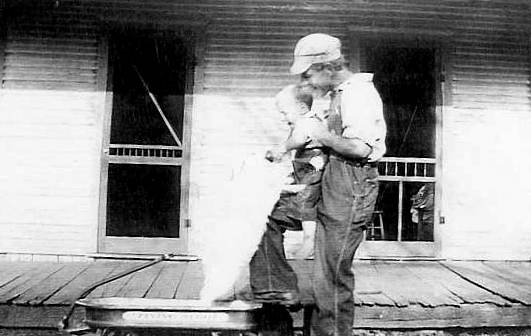
21 Waldo and Sherril in First Home Income from the chickens, loans from the Bank of Brumley, Dad’s carpenter skills, Mom’s tending the kids, feeding the hired help and doing farm chores permitted Dad to focus his mental and physical energy on an unending stream of construction projects that slowly increased the production of their property. The “20 X 20” chicken house was the first project after the wedding. This was a frame building with a loft and concrete floor. The main floor was equipped with roosts and nests for laying hens. The “30 X 30” was also equipped with roosts and nests for laying hens and those two buildings were used for egg production during the next few years.
Providing drinking water for all the chickens soon became a great labor problem. Water had to be drawn by hand from the well in the washhouse, pumped from the cistern in the kitchen or dipped from the spring. The best alternative was dipping from the spring and Dad purchased The Old Jenny (a female donkey) for $20.00 and built a two wheel cart that held a 55 gallon barrel of water (photo 22).
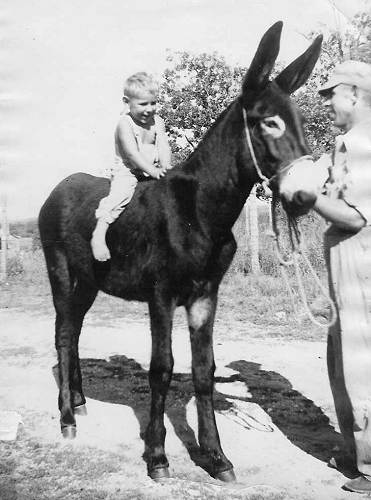
22 Waldo's Donkey Each day The Old Jenny was harnessed, hitched to the water cart and taken to the spring where Dad or Mom dipped the water from the spring and poured it into the barrel. The Old Jenny pulled the water cart up the hill and waited at each chicken house while the water was dipped from the barrel and carried into the chicken house.
The Old Jenny was a great investment. She not only pulled the water cart, but also a small cart that was used to transport rocks, feed, manure, etc. She was gentle and all us kids rode her at will. In addition she was bred every year in hopes of getting a baby jenny or jack. She only produced one colt (a jack or male donkey) in 1938 that was sold to Andrew Thornsberry for $500 in 1939. Wow!! People worked for less than $500 per year in those days.
Andrew offered the jack for stud service. Breeding a female horse to a jack produced a mule. Many farmers preferred mules for draft (pulling a wagon, plow, mower, etc.) work, including Dad and Grandpa Steen. Grandpa Popplewell always used horses for draft work. I sense that their rationale was similar to my rationale for always driving Ford products…personal preference.
Dad kept up with the latest poultry research and by this time the journals had reported that chickens normally laid eggs in “clutches.” That is they laid an egg a day for several days in a row, and then skipped a day. The number of eggs produced before the day of rest was proportional to the amount of daylight. Dad bought a 32 volt direct current dynamo and installed it in the basement of the “30 X 30’ to extend the daylight hours for the laying hens and thereby induce the hens to lay more eggs. When it got dark, they cranked the generator by hand and ran it until bedtime, then shut it off. There were no storage batteries so they only had electricity when the engine was running.
The next project was the “wash house” attached to a round chicken house built over a round basement. Entry to the chicken house and basement was through the “wash house.” The “wash house” was built over the well that supplied drinking water for the family, hired help and visitors. Cash was limited and this project was built from native rock, laid by hand, similar to the “30 X 30.” Dad got his first experience with dynamite while digging the round basement. The blasting didn’t go well and added considerable cost to the low budget project. Dad used the basement under the round part for his incubators. He had three sets down there. Coal oil heaters warmed the incubators and Carol (Sherril’s sister) remembers him taking coal oil to the basement in a 55 gallon drum. Dad told Carol that he started down there one time and let the barrel get away from him. He out ran the barrel as it tumbled down the stairs and escaped injury.
Following this project was another small rock building just North of the “wash house” to house the dynamo. This building was called the “engine house” and had space for the dynamo and a bank of batteries that could supply limited power without the engine running. Mom got her first major appliance about this time…a motor driven washing machine with a wringer. Dad equipped the machine with a 32 volt motor and connected the wash house, “30 X 30” and “20 X 20” to the 32 volt electrical system that was housed in the “engine house.” Mom cranked the dynamo by hand every Monday and Friday and it ran throughout the morning while the washing machine was in use. The dynamo was also cranked each evening to provide lights for the hens in the two laying houses.
By this time Dad and Mom had chicken houses scattered over the 40 acres. South of the house was the 30 X 30, 20 X 20 and the 3-section. West of the house was the small round rock house and a small frame house. East of the house was the wash house, engine house, outdoor toilet, log car shed, log brooder house and two frame brooder houses. North of the house was the barn, duck shed and shop. Dad had built all of the buildings except for the house, barn, car shed, log brooder house, outdoor toilet and duck shed.
Needless to say, carrying (hauling water, wood and feed) for all the chickens and constructing all the buildings left little time for sleep. As a result Dad had considerable difficulty waking up during the night to tend the wood stoves that heated the brooder houses. To solve this problem, he put an old wind up alarm in a tub under the bed, which made lots of noise when the alarm sounded, but it wasn’t enough to prod a very tired man from a warm bed. He then built a shelf on the south bedroom wall for the alarm clock and a hinged shelf over his side of the bed. He ran a string from the alarm winding key on the clock, through pulleys and eye bolts to a trigger that supported the hinged shelf until tension was applied to the string. The hinged shelf supported a tobacco sack filled with wheat that was supposed to hit Dad in the face when the alarm went off. Dad said that worked for a few days until he learned to dodge the falling sack of wheat.
In 1939 Dad installed a water system that provided running water to all the poultry buildings. He built a rock house over the spring that had always supplied water for the livestock and poultry and installed a 32 volt pump and pressure tank. Ditches were dug at least 18 inches deep with picks and shovels to protect the pipe from freezing. When solid rock was encountered, dynamite was used to shatter the rock. I remember well the “fire in the hole” alarm that always preceded the blast and flying debris. What an exciting time for a three year old boy.
Completion of the water system was a significant event. Hauling water to the chicken houses in the 55 gallon water cart with the old Jenny was a labor intensive process that had to be done every day. The old Jenny’s job was reduced to letting the kids ride her back until she would get tired. When she got tired, she would walk under the roof of the duck shed and scrape off the kid that happened to be on her back at the time (photo 23).
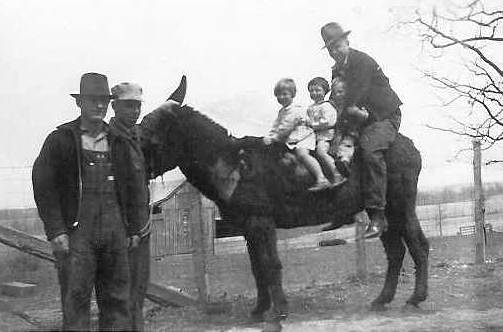
23 Waldo and Donkey Although water was never piped into the house, Mom’s life also became easier. Wash days (Monday and Friday) consisted of drawing water from the well to fill the kettle, starting a fire under the kettle and returning to the house to fix breakfast for the family. Following breakfast, she would draw more water to rinse the clothes, start the dynamo, wash the clothes and hang the clothes on the clothesline or fence to dry. The water system saved considerable time and energy compared to drawing 60 or more gallons of water from the well with the 10 quart bucket. Note that the outdoor toilet continued in use until we moved into the dream home (that’s another story) in 1945.
By the time I started to school in 1940, we had every thing a family could possible dream of. We had a little cash income from selling chickens, eggs, cream, pigs and calves. We had plenty of vegetables from the garden, milk from the cows, meat from the hogs or chickens and flour, sugar salt, spices and clothing from the Farmers Exchange, Porters Store, Sears & Roebuck or Montgomery Ward catalogues. Most of the neighbors had those things also, but we had electricity and running water…the latest technology. Our neighbors were destined to wait seven more years (until after WWII) before electricity became available.
Thanks Sherril.
Sherril’s father, Waldo Steen, was the oldest of the seven children of Frank and Ella Steen having been born in 1907. Here is a family photo of the Frank Steen family and their adult children (photo 24):
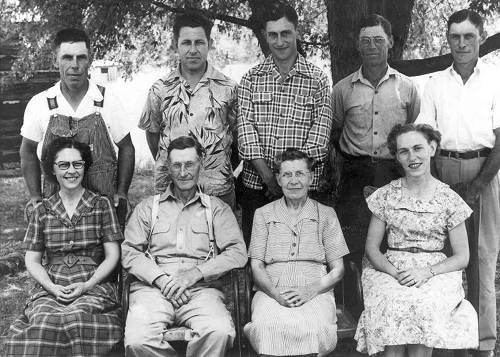
24 Waldo, John, Paul, Kermit, Holmes, Vergie, Frank, Ellie and Icie Waldo may have been the most interesting of the Frank and Ella Steen family. Many stories are remembered fondly by friends and members of the Waldo Steen family regarding their life on the farm as described by Sherril above. Bamber Wright told me that Waldo’s farm had more operations going than most and that the sheds and barns all had their own fence and gate. Bamber, who at the time was delivering feed from the Anchor Milling Company in Tuscumbia, said that Waldo had so many places to unload the feed and so many gates to go through, that he usually allowed a little more time for the day when a trip to Waldo’s farm was scheduled. One landmark still present today is the silo built on top of one of the barns, which when viewed from the west, looks as if it isn’t centered well (photo 25).
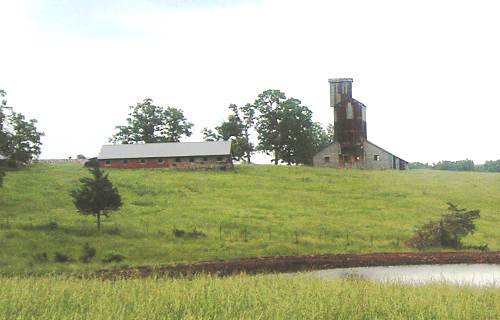
25 Waldo's Grain Barn and Silo However, considering that it has been in that position for about sixty five years now, I suppose it isn’t likely to fall in our lifetimes.
According to Sherril Steen the little building on top of the grain elevator housed the equipment that lifted the grain from the dump bin at ground level to the top of the elevator. The elevator equipment consisted of an endless belt (powered by an electric motor) about 6 inches wide that was stretched over pulleys from below the dump bin to the little building on top of the elevator. The endless belt had little grain cups (each held about one quart) fastened about every 9 inches along the belt. The grain cups would pick up the grain below the dump bin and carry the grain to the top. As the grain cups passed over the top pulley, the open cup would spill the grain out. The grain would then flow through a pipe to one of the eight grain bins in the elevator.
The following is quoted from Sue Steen Cates:
“Waldo, being the oldest of the seven children of Frank and Ella Steen, probably was expected to help his father at home. I know he was always a very loyal son. He was said to be a “book worm” and to be “very smart in school,” according to those who knew him.”
After a couple of summers going to the South Dakota and Kansas harvest Waldo married Eula Popplewell in 1932 and the couple moved to a house on the north side of the Frank Steen farm signing a note for $1500 for the full price. The sale of 1,200 chickens before the wedding day had purchased used furniture for the house (photo 26).
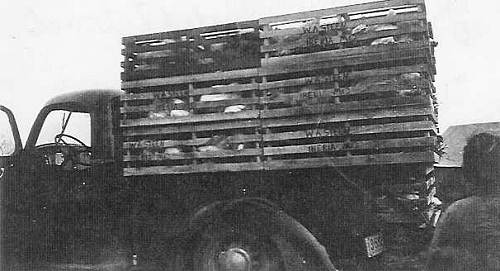
26 Waldo's Chicken Truck In the years to follow, the farm would produce a succession of chickens, geese, guineas, ducks and turkeys including a permanent number of milk cows. Later he established a “farrow to finish” hog operation (photos 27 and 28).
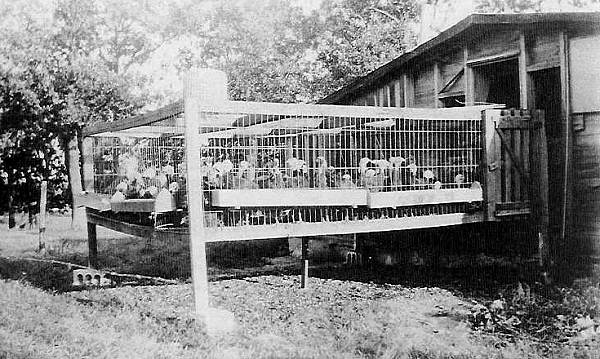
27 Turkey Sun Porch
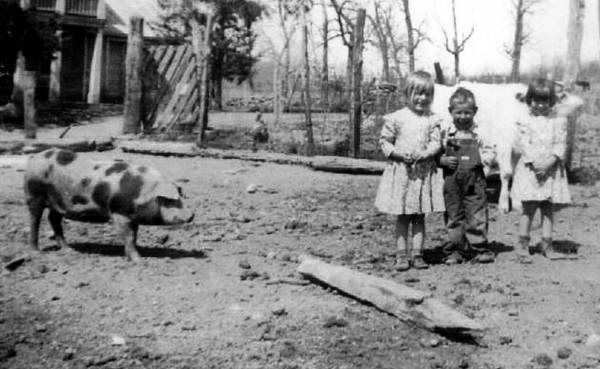
28 Carol, Jerry, Sherril and Pig Following the birth of nine children, three boys and six girls, Waldo and Eula became concerned about the spiritual growth of their large family. A decision was made to attend the Hickory Point Baptist Church. That first Sunday in 1947 was an event neither the family nor the church members were likely to forget. Waldo loaded (literally) everyone into and onto a 1945 Chevrolet flat bed truck. It was the farm vehicle. Eula says no one seemed to mind that they traveled 20 minutes over gravel roads and she never heard a complaint about blown hair or dusty seats. It would have been impossible for this brood to have made a quiet entrance in that one room country church. Thirty in attendance was considered a crowd. However their entrance, the members welcomed this family of 11 (a truckload) and that day began a church attendance that would span the next 25 years.
Waldo’s children have memories of their dad singing as he went about his work on the farm. It might be in the turkey houses or driving the tractor or jeep. He would sit on the steps in the back entry singing at the top of his lungs. In the winter time there was “Footprints in the Snow.” Dry times reminded him of “It Ain’t Gonna Rain No More.” He sang “Letter Edged in Black” and became very disgusted with himself when he couldn’t remember all the words. He and Eula Maye (daughter) sang together once at church.
Waldo and Eula provided piano lessons for all their children except the older three. Sometimes Waldo would come in the house while Eula Maye was playing He would say, “Maye, play ‘Lily of the Valley.’ What page is that?” And so would begin the hymn singing for awhile.
Waldo Steen was not noted for his punctuality. The family had a reputation for being late. But Eula Maye remembers that if she was to play at any church for a service, he always managed to be on time. He was proud of her playing.
Photos of the Waldo and Eula Steen children indicate that they played together happily. Here are some photos of those years (photos 29, 30 and 31):
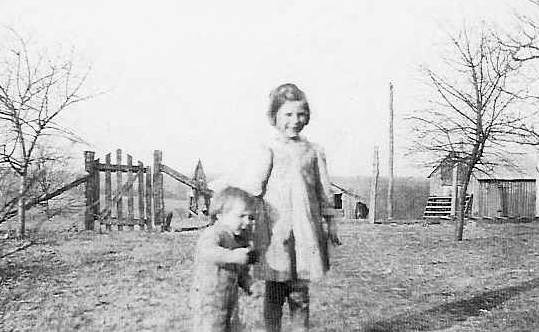
29 Sherril and Carol Steen at Farm
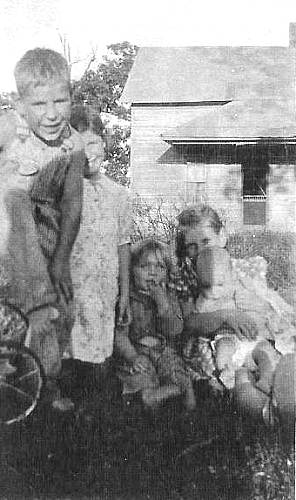
30 Sherril, Jerry, Carol, Janet and Alice Steen
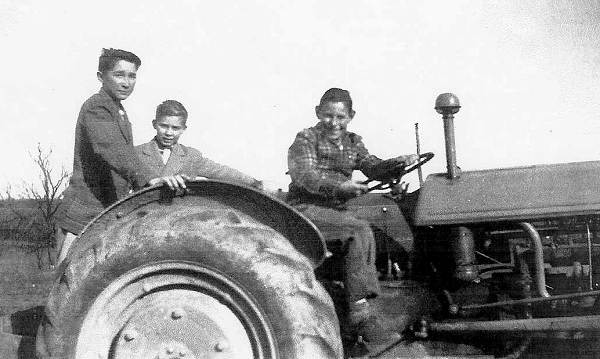
31 Sherril Driving In 1942 Waldo and his brother Holmes went to Colorado to work at the construction of Camp Hale, a facility being built to train soldiers how to maneuver in mountainous areas. They worked for about four months on that project.
In 2005 some of Holmes’ children visited that site. Shown is daughter Sharon and her husband, Paul Holder, reading one of the signs (photo 33).
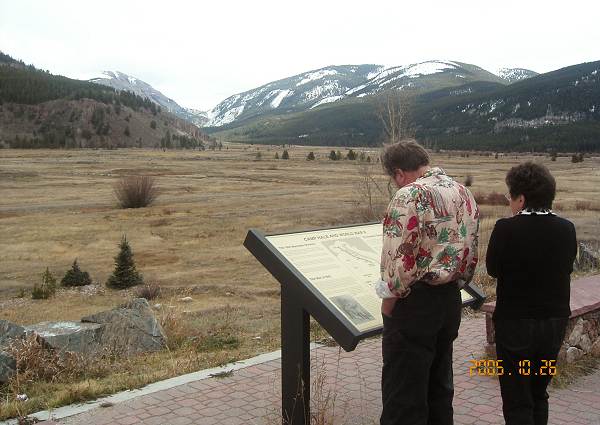
33 Camp Hale Colorado - Paul and Sharon Steen Holder Sherril and I have talked about farm trucks. He remembers they had a 1939 or 1940 International truck that his mother wrecked in the spring of 1945 near Ulman. Lin Lupardus (worked for Gene Waite) was inured in that accident and Sherril was sure that his dad paid $1000 to Lin for his injuries. That truck was a total loss. Following the accident, Waldo got a permit to purchase a new truck. The new 1 ½ ton 1945 Chevrolet truck arrived on September 4, 1945, just before Eula Maye was born on the 12th. Note that this was the truck that transported the family to church that Sunday in 1947.
In the late 1940’s Waldo purchased a new 1947 Kaiser car. Usually, Waldo drove his truck, although at one time early on he had an early model Ford (photo 34).
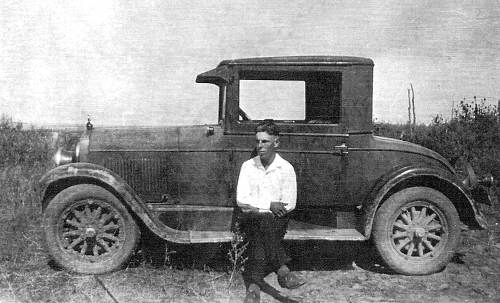
34 Waldo Steen with Ford The new car inspired a trip for the entire family to go to Colorado probably to show the family where he had worked earlier in 1942 (photo 35).
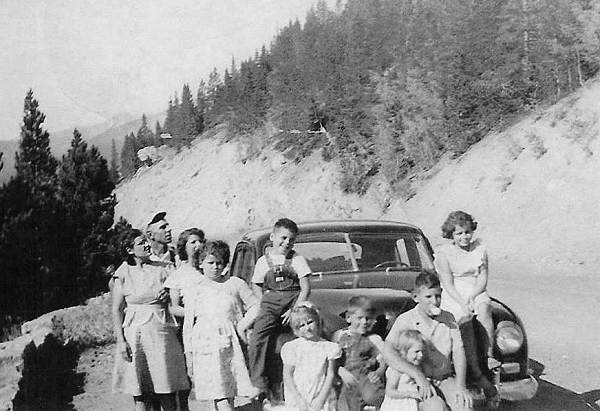
35 Waldo Steen Family in Colorado I don’t know how all the children fit in the car! Here is a list of the names (Carol was taking the photo): Eula, Waldo, Jerry, Janet, Jim, Marilyn, Roger, Eula Maye, Sherril, and Alice.
During that time, the Steens would experience the joys of growing children and the grief that comes with the loss of a child. Roger fell from the grain elevator in 1951 and died. He was eight years old (photo 36).
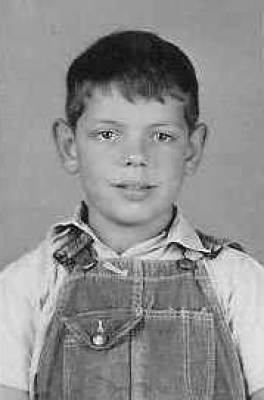
36 Roger Steen In 1972, the decision was made to sell the family farm. The years had brought many changes. This property had long since been purchased from Frank and Ella. Using his carpentry skills, Waldo had replaced that first three room structure with a three story, six bedroom home (photo 37).
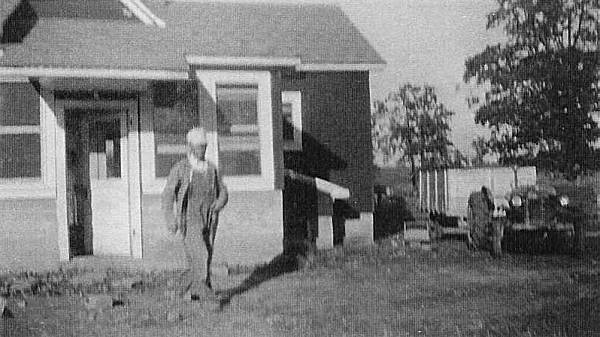
37 Waldo Steen and Second Home Obsolete buildings had been torn down and replaced with poultry houses. A new farrowing house was built and some of the poultry buildings converted into hog handling facilities.
After the farm auction, the couple moved to Eldon. As noted above, during the forties, Waldo had helped build Fort Leonard Wood and Camp Hale at Pando, Colorado. Now he returned to carpentry at the construction sites of the Kansas City Airport and Truman Dam. In 1972, Eula embarked upon an adventure of her own. Having never worked outside the home, she spent almost two years in the employment of Fischer Footwear.
In 1979, they saw the working years behind them and that year was spent building a new home in Eldon. In 1992 their eight children returned for their celebration of sixty years of marriage. It had been forty years since they had all been together (photo 38).
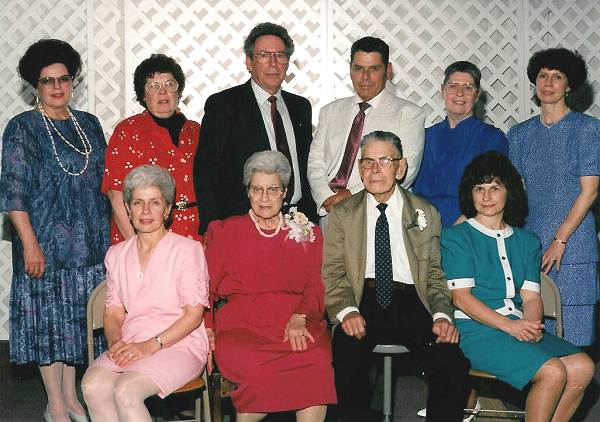
38 Waldo and Eula 60th Anniversary - 1992 In the photo upper row are Janet, Carol, Sherril, Jim, Geraldine and Eula Maye. In the bottom row are Alice, Eula, Waldo and Marilyn.
Thanks Sue for this interesting and detailed history of the Steen family.
As noted above I have been tracking the Miller County Steen family history through the line of Sherril Steen, son of Waldo. Sue’s history of the Steen family “How Do I Fit In,” contains more detail about other of the Steen family members.
Sherril Steen is one of those rare people for whom it can be said never wasted a moment. His was a life of service to our country as he was a career member of the military. He began early in 1953 with the Marine Corps and retired from the Air Force as a Lieutenant Colonel in 1982. As is the case with all career military people, one thing is certain: the military will require you to constantly be on the move. But for Sherril every change of location was seen as an opportunity to learn and develop new skills; one example was his persistent effort to further his education eventually obtaining a Master’s Degree in Electrical Engineering from the University of Missouri in 1974. The only way truly to appreciate what he accomplished, the awards he received and the many translocations required is to take a look at his career history, and following that, the list of the many places he has lived:
Military History of Waldo S. Steen
- October 1953-December 1953 Marine Corp Recruit Depot, San Diego, CA
- January 1954-October 1955 1st Antiaircraft Artillery Battalion, 29 Palms, CA
- January 1956-January 1959 University of Missouri, College of Agriculture, Columbia, MO
- January 1959-August 1960 University of Missouri, Fertilizer Control Division, Columbia, MO
- August 1960-November 1964 MO State Highway Dept., Geology & Soils Dept., St. Joseph, MO
- November 1964-February 1965 Officers Training School, Lackland AFB, TX
- Commissioned as 2nd Lt., USAF on 2/10/1965
- February 1965-January 1966 Communication Officers Course, Keesler AFB, MS
- January 1966-May 1968 AUTODIN Coordination Station, Tinker AFB, OK
- May 1968-August 1971 Defense Communications Agency, Ft. Carson, CO
- August 1971-June 1974 University of Missouri, College of Engineering, Columbia, MO
- MSEE, June 1974 (Master of Science, Electrical Engineering)
- June 1974-August 1976 2129 Communications Squadron, CCK AB, Taiwan
- Commander, 2129th Communications Squadron, August 1975-August 1976
- August 1976-November 1977 Headquarters, Air Force Communications Service, Richards Gebaur AFB, MO
- November 1977-August 1979 Headquarters, Air Force Communications Service, Scott AFB, IL
- August 1979-June 1980 Air Command & Staff College, Maxwell AFB, AL
- June 1980-November 1982 European Communications Division, Kapaun AS, Germany
- 9/30/1980 promoted to 0-5, Lt. Col.
- 11/30/1982 retired from the USAF at McGuire AFB, NJ
- Small Arms Expert Marksmanship Ribbon
- Air Force Longevity Service Award Ribbon with three (3) Bronze Oak Leaf Clusters
- National Defense Service Medal
- Air Force Commendation Medal
- Joint Services Commendation Medal
- Meritorious Service Medal
Places Sherril and Alice Lived
- February 1953 to January 1954—With our parents
- January 1954 to October 1955—Base Housing, (29’ House Trailer) 29 Palms, CA USMC
- October 1955 to January 1956—With our parents
- January 1956 to February 1959—Powell’s Trailer Court (31’ House Trailer), Columbia, MO, UMC
- February 1959 to August 1960—Sunset Trailer Park (10’ X 50’ House Trailer), Columbia, MO
- August 1960 to December 1964—3926 Pickett Road, (10’ X 50’ House Trailer), St. Joseph, MO
- December 1964 to February 1965—Rented house in Castroville, TX USAF Officer Training
- February 1965 to February 1966—200 Baker Street, (10’ X 50’ House Trailer), Biloxi, MS
- February 1966 to January 1968—17 Debra Drive, (10’ X 50’ House Trailer), Midwest City, OK
- January 1968 to May 1968—713 Royal, Midwest City, OK, First house
- May 1968 to August 1971—3680 Michigan Ave, Colorado Springs, CO
- August 1971 to May 1974—4109 West Rollins Road, Columbia, MO, UMC for MSEE
- May 1974 to June 1975—New BOT Housing Compound, Taichung, Taiwan
- June 1975 to June 1976—BOT Housing Compound, Taichung, Taiwan
- June 1976 to November1977—12528 Askew, Grandview, MO
- November 1977 to August 1979—Covered Bridge Estates, RR1, Belleville, IL
- August 1979 to June 1980—356 Hillabee Dr., Montgomery, AL
- June 1980 to November 1982—Vogelweh Housing, Kaiserslautern, Germany
- November 1982 to June 1983—Minnie Winnie (Motor Home) in Florida and Kansas City, MO
- June 1983 to April 1984—12528 Askew, Grandview, MO
- April 1984 to February 1990—1816 Morris Dr, Cherry Hill, NJ
- February 1990 to August 1998—247 Saint David Dr., Mt. Laurel, NJ
- August 1998 to Present—1261 Pritchard Lane, Weatherford, TX
After retirement from the Air Force Sherril moved to New Jersey to take a position as Program Manager for RCA on a project to build 111 tactical satellite communication terminals for the USAF. Soon after he joined RCA the company was purchased by GE which in turn sold the Aerospace unit to Martin Marietta. Just before he retired Martin Marietta and Lockheed merged into the present day Lockheed Martin. He worked in program management and system engineering for these companies for ten years before retiring and moving to Weatherford,Texas in 1998.
I am sure that to most parents the respect and love received from their children is perhaps the most important value of their lives. Sherril and Alice Steen certainly are blessed in that regard. I asked Dana Steen Maloney to compose a narrative for us about her parents. Her love and respect for them is amply demonstrated in the following essay:
Sherril Steen’s Greatest Asset
Waldo Sherril Steen was born in Iberia, Missouri on February 19, 1936.
During his early years on a small farm in Iberia, Missouri, Waldo “Sherril” Steen had no idea he would someday accumulate sufficient assets to be able to contribute financial support to the Miller County Historical Society. He was in his fifties before his dreams of getting ahead started coming true. He attributes much of the success of their transformation from living poorly to living comfortably to his wife, Alice Faye Pemberton.
Sherril Steen was born in Iberia in 1936, during the Great Depression. His parents, Waldo and Eula Steen, had a forty acre farm. Eula gave birth to nine children in eleven years. Sherril was the third child, first son. He says they woke up with snow on their bed in winter, and did farm work without shoes in summer.
When he was nine years old, Sherril saw Alice for the first time, “the prettiest girl in the world.” He recalls the details of her new yellow dress, her dark hair in rag curls, and a ribbon bow on one side. Sherril was excited to graduate from the 8th grade at the Honey Springs one-room schoolhouse because he had high hopes of seeing Alice Pemberton in high school. On the very first day, he sat next to her on the bus. He still remembers gazing at her full red lips and dark wavy hair. She took his breath away.
In 1953, one week before he turned seventeen, Sherril and Alice married. Their first child, Douglas Sherril, was born while Sherril was a Marine stationed in 29 Palms, California. Their second son, Darrel Lynn, was born just before he received his Bachelor’s Degree in Agriculture at the University of Missouri. Their daughter, Dana Faye, was born while he was working for the Highway Department in St. Joseph, Missouri. At the age of 28, he joined the Air Force as a Communications Officer.
“Five of us lived in a space the size of a tractor trailer,” he says. “Alice worked hard to keep it neat. We were always moving forward, but progress was slow until a few years after I joined the Air Force.” After fifteen years in a mobile home, they were finally able to buy their first house in 1968.
Because the Air Force needed more engineers they sent Sherril to the University of Missouri in Columbia in 1971. In three years he earned a Bachelor’s and a Master’s Degree in Electrical Engineering. Those degrees propelled his success and led – after his retirement from the Air Force as a Lieutenant Colonel in 1983 – to a ten year career at Lockheed Martin.
In 1998 Sherril and Alice moved – for the 23rd time – to Weatherford, Texas. Twice they lived in foreign countries. They share two hobbies: spending time with family and seeing the world. Wherever they are, they enjoy being together. Sherril gives Alice a lot of credit for their financial success: “She’s always been remarkably good at stretching a dollar. I married the right woman.” (photo 38a).
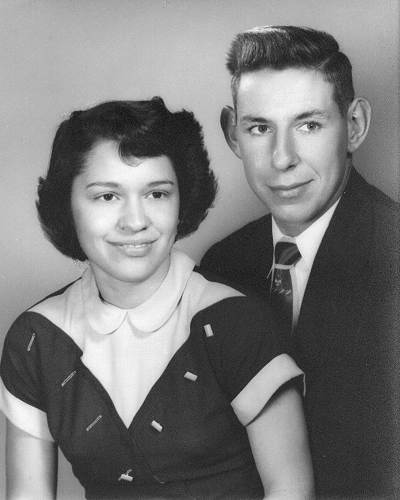
38a Mom and Dad Wedding Photo Sherill Steen says he is pleased that the assets he and Alice have accumulated are sufficient to allow a contribution to the Miller County Historical Society. He is much aware, though, that their greatest asset is love.
The author, Dana Steen Maloney, was born in St. Joe, MO on Nov. 15, 1961. She wrote the biography in February 2010.
Thanks Dana for that beautifully written tribute to your parents!
Sherril flies his own airplane and lives next to his own runway in Weatherford (photo 39).
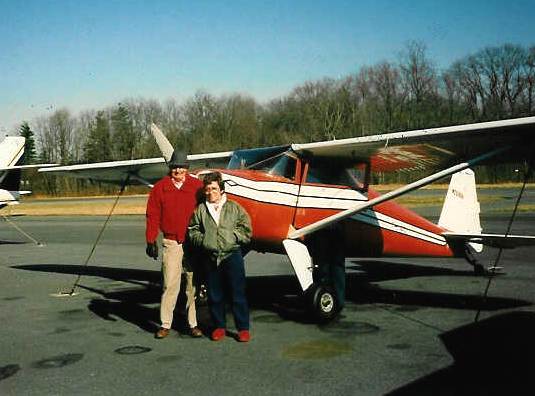
39 Sherril and Alice and Plane Since retirement Sherril and Alice have enjoyed several extended cruises visiting many places in the world. The couple has been extremely supportive of all the Miller County Historical Society projects, most especially recently making the MCHS Foundation the beneficiary of their IRA. Meanwhile, they will donate the required minimum distribution ($11,500 in 2010) to the Miller County Historical Society each year. The objective of the Foundation is to provide members and friends of the MCHS with a means to make gifts which will continue to support the MCHS’s mission in perpetuity. The Foundation’s funds will be managed professionally for growth, with the annual distribution (about 5%) going toward meeting the MCHS’s annual operating expenses. Therefore, the Foundation will assure a bright financial future for the MCHS.
Thank you Sherril and Alice!!!!
This week’s copy from the C.B. Wright journal is taken from selections of the June/July 1912 diary (photos 40 and 41).
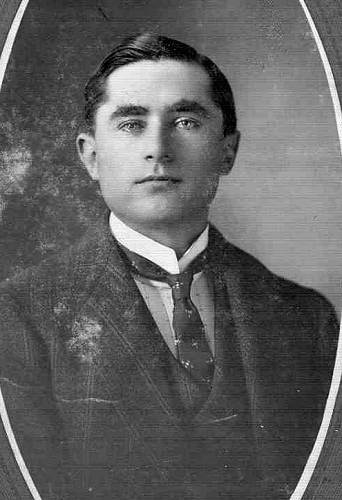
40 Clarence Wright
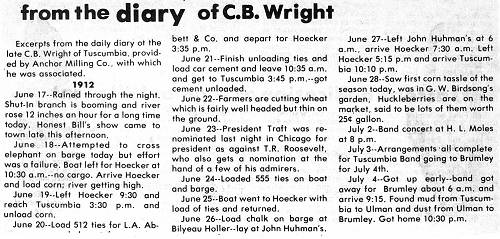
41 C.B. Wright Diary - June and July 1912
Click image for larger viewSurely, the event about the elephant to which C.B. gives only one short sentence deserves more looking into! I mean, just how often was Tuscumbia visited by an elephant anyway! So I looked it up and found the story as told by Ed Wright on a previous edition Progress Notes (photo 42).
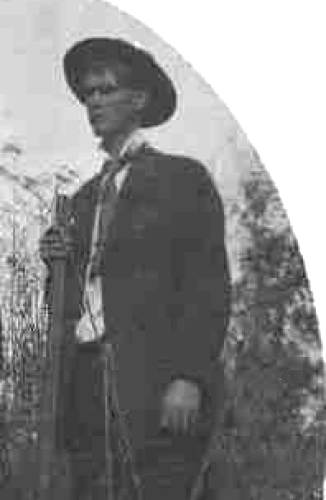
42 Ed Wright “Ed Wright can remember when one of the boats was used to attempt to ferry an elephant across the Osage. He said a traveling show had come through and the elephant would not cross the bridge. "We got him on the barge all right," he said, but the elephant jumped off into the river. Wright said the elephant surfaced under the boat and it rolled off its back. The elephant was gotten across by towing him with the boat, but then the animal could not get out of the river because the bank was too steep. "By that time there was 100 (people) down there," he said. Ropes were brought from the mill and the animal was finally pulled up the bank and sent on its way with nothing more serious than a broken tusk.”
After reading once again Ed’s story I remembered I was told by someone that the owner of the traveling show, “Honest Bill”, paid several locals to dive into the river to try and retrieve the broken tusk. I imagine that the tusk was worth some money due to its ivory!
Last week a celebration of Sylvia Long’s one hundredth birthday was held at the First Baptist Church Family Life Center in Eldon (photo 43).
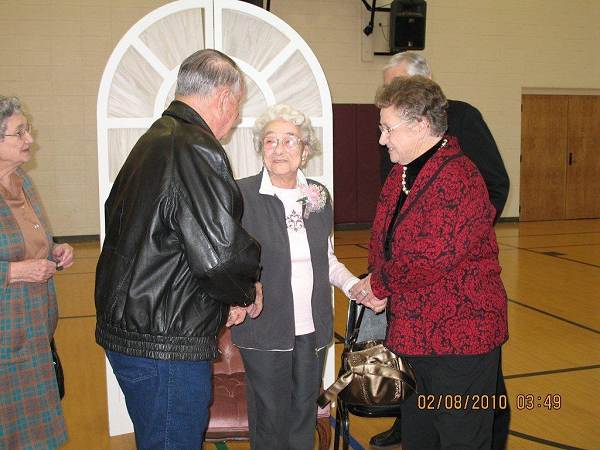
43 Sylvia at 100 She and her husband, Ralph, were well known since for many years they owned and operated the Long General Store in Brumley (photo 44).
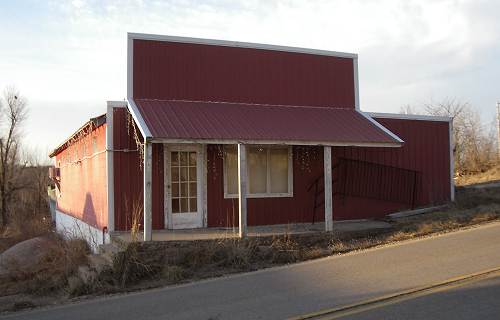
44 Ralph Long Store - Brumley Sylvia was born Feb. 3, 1910, in Brumley, to Frank and Lila (Cox) Ramsey. Many local residents fondly remember the Long’s and their store. The event reminded me of a short anecdote told by Lois Mace Webb involving Sylvia and Lois’s father, Lucian Mace, placed on a previous Progress Notes.
“Sylvia Ramsey Long, who taught at Brumley, can still giggle about antics during those years. On one trip she rode with dad in a roadster with rumble seat and leaky composition roof – likely a forerunner to the convertible. One rainy day, nearing Tuscumbia, they offered a ride to two women. The rumble seat was out of the question. The women, according to Sylvia and dad’s story, were large; the car seats small. Sylvia opened an umbrella in an effort to divert water coming through the roof. Visibility could be called poor at best. Finally, seeking solution to a dual dilemma, dad opened his car door thinking if he leaned out he could 1) see the road better, and 2) give the ladies a little more space. And I believe they mentioned a body odor issue. Regardless, a major dilemma developed when dad discovered he could neither reclose the door nor slide back into the seat -- a law of physics I suppose, something about the amount of matter that could occupy a specific space. Sylvia and her husband Ralph laughed about those incidents with mom and dad into their later years – years that saw the couples enjoy trips to Mexico and South Texas, or in domino games at home. Ralph and Sylvia Long operated a grocery store in Brumley until their retirement.”
Sylvia presently lives at the Lee House in Eldon where three other centenarians live as well: Helen Phillips who is 101, Lois Crismon 106, and Blanche Keller 101 (photo 45).
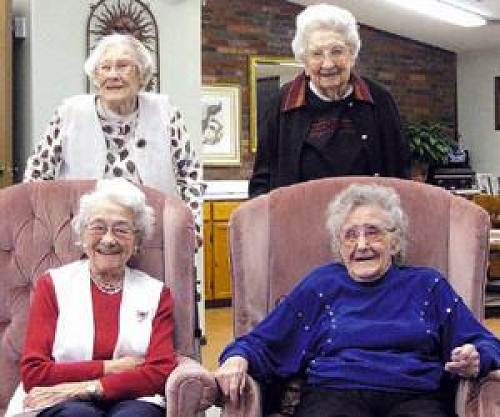
45 Blanche Keller, Helen Phillips, Sylvia Long and Lois Crismon
A week ago last Saturday on February 6th I and Judy attended the sixtieth wedding anniversary of G.R. and Jean Keeth of Iberia. The Keeths’ have been supporters of the Miller County Historical Society for years so it was a pleasure to join their friends and relatives for the occasion. The announcement card sent by the family to announce the event was clever in the way it portrayed the couple at three different stages of their life (photo 46).
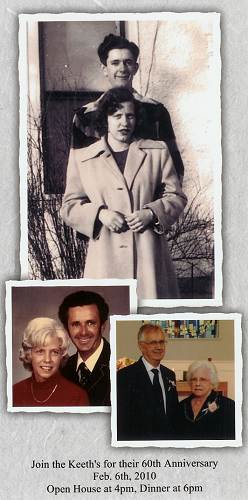
46 Keeth 60th Anniversary Invitation
Click image for larger viewA large crowd estimated at over one hundred people came to honor G.R. and Jean (photo 47).
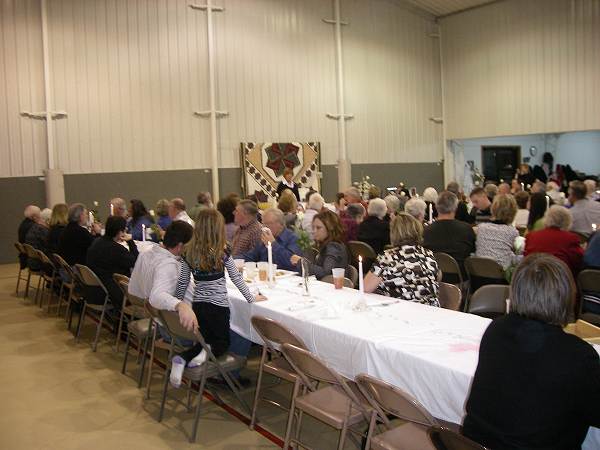
47 Keeth Family and Friends A number of quilts made by Jean were hung on the walls of the event center of the First Christian Church of Iberia where the event was celebrated (photo 48).
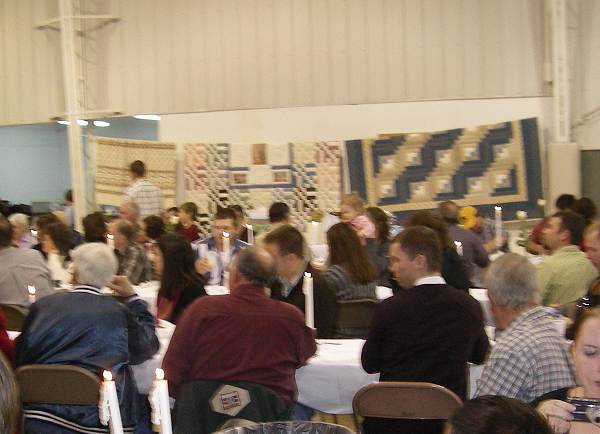
48 Quilts An audio visual display had been prepared by the family giving the life story of G.R. and Jean (photo 49).
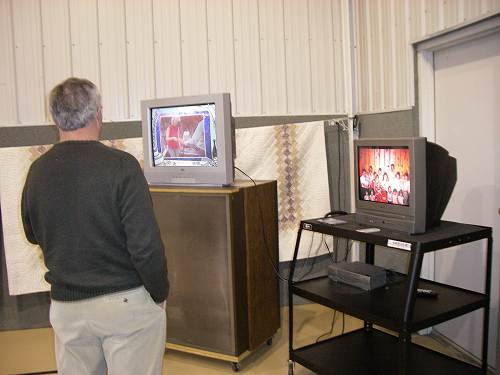
49 Audio Visual Display The anniversary cake was as good as it looks (photo 50).
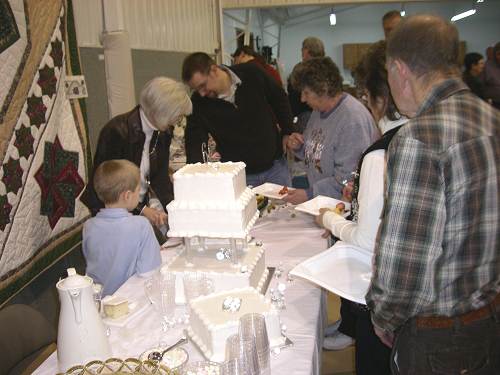
50 Anniversary Cake Greg Keeth, son of G.R. and Jean, gave an endearing testimony to his parents as did others including many grandchildren (photo 51).
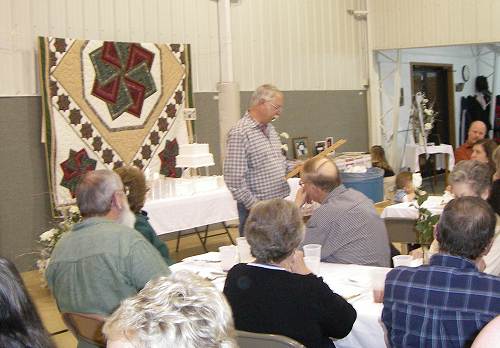
51 Greg Keeth Greg recently was nominated by the Board of Directors of the Miller County Historical Society to become a member of our board. He and his wife Pam have been very helpful to us at various functions and events. All in all I believe that G.R. and Jean were very pleased by the outpouring of affection and friendship shown them by their friends and relatives (photo 52).
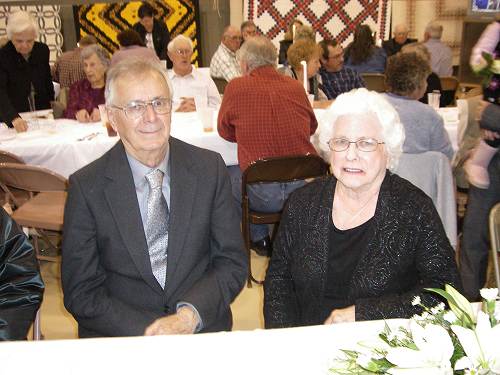
52 G.R. and Jean Keeth That’s all for this week.
 Joe Pryor
|



